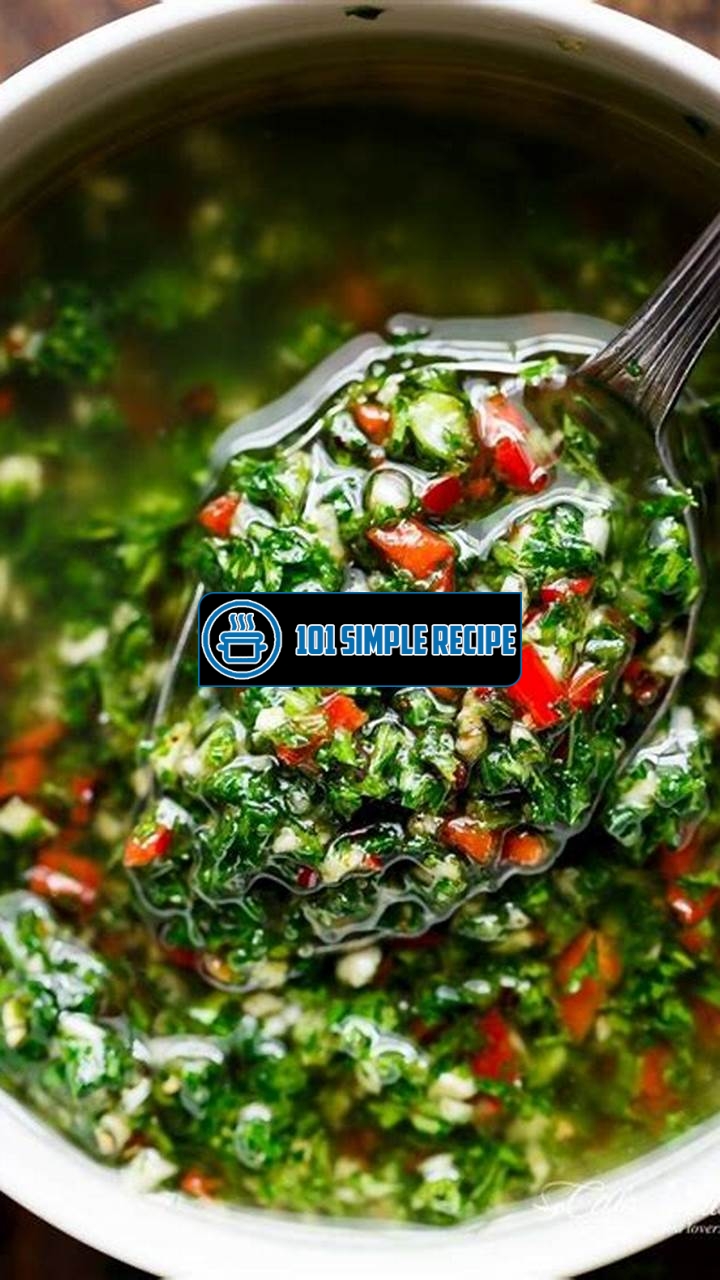If you’re craving a burst of flavor that will transport you to the vibrant streets of Argentina, look no further than our authentic Chimichurri recipe. ️ This mouthwatering sauce is a staple in Argentinian cuisine, adding a zesty punch to grilled meats, vegetables, and even sandwiches. Made with a blend of fresh herbs, tangy vinegar, garlic, and a hint of spice, Chimichurri is the ultimate companion to elevate your culinary creations. Get ready to savor the taste of Argentina with our simple yet exquisite recipe. ✨

The Origins of Chimichurri Sauce
Chimichurri sauce has a fascinating history that dates back to the 19th century in Argentina. This flavorful sauce is an integral part of Argentine cuisine and is commonly served with grilled meats. The origins of chimichurri can be traced back to the gauchos, the South American cowboys. These skilled horsemen spent their days herding cattle across the vast pampas of Argentina, and they needed a sauce that would provide both flavor and nutrition during their long journeys.
The Story Behind Chimichurri
The exact origin of the word “Chimichurri” remains a subject of debate, with several theories proposed over the years. One theory suggests that it derived from the Basque word “tximitxurri,” which means “a mixture of several things in no particular order.” Another theory claims that it is the mispronunciation of the English words “Jimmy Curry” by the British immigrants who settled in Argentina.
Regardless of its etymology, chimichurri quickly became a beloved condiment in Argentina due to its bright and tangy flavors. The gauchos would gather wild herbs, such as oregano and parsley, along their journeys and combine them with garlic, vinegar, and oil to create the sauce. This simple yet delicious mixture not only added taste to their meals but also served as a natural preservative for the meat they carried.
The Ingredients of Traditional Chimichurri
Traditional chimichurri sauce consists of a handful of simple ingredients that come together to create a burst of flavors. The key components include:
- Parsley: A generous amount of fresh parsley, finely chopped, forms the base of the sauce. It adds a refreshing and earthy element to the chimichurri.
- Garlic: Several cloves of garlic, crushed or minced, contribute a pungent and aromatic essence to the sauce. The intensity of garlic can be adjusted according to personal preference.
- Oregano: A sprinkling of dried oregano adds a hint of herbal bitterness and complexity to the sauce.
- Red Wine Vinegar: The tangy acidity of red wine vinegar provides a pleasant contrast to the other flavors. It helps to balance the richness of the oil and enhance the overall taste of the chimichurri.
- Olive Oil: High-quality extra virgin olive oil binds all the ingredients together and gives the sauce a luscious consistency.
- Salt and Pepper: A pinch of salt and pepper is added to enhance the flavors and bring out the natural taste of the ingredients.
- Red Pepper Flakes (optional): For those who enjoy a bit of spice, a sprinkle of red pepper flakes can be added to give the chimichurri a fiery kick.
The Various Versions of Chimichurri
While the traditional chimichurri recipe remains the most popular, there are variations of the sauce throughout Argentina and even beyond its borders. Some variations may include additional ingredients such as lemon juice, paprika, cilantro, or even tomato. Each version brings a unique twist to the classic sauce, offering a range of flavors to cater to different palates.
In conclusion, chimichurri sauce is deeply rooted in Argentina’s culinary heritage and has become emblematic of the country’s vibrant flavors. Its origins with the gauchos and its evolution over time have created a sauce that is both versatile and delicious. So next time you fire up the grill for a mouthwatering steak or barbecued chicken, don’t forget to whip up a batch of authentic chimichurri sauce to elevate your meal to new heights!
If you’re interested in more delicious recipes, you can check out our argentinian chimichurri recipe. It’s a classic sauce from Argentina that goes perfectly with grilled meats.
The Science of Flavor in Chimichurri Sauce
Uncover the flavor profile and key ingredients that make this sauce so delicious.
The Role of Herbs and Spices
Herbs and spices are the backbone of any great chimichurri sauce. They are responsible for adding complexity and depth of flavor to this Argentinean staple.
In traditional Argentinian chimichurri, the key herbs used are parsley and oregano. These herbs bring a fresh and earthy taste to the sauce, while also providing a vibrant green color. The parsley adds a slightly bitter note, while the oregano offers a warm and aromatic flavor.
Additionally, garlic plays a crucial role in chimichurri sauce. It infuses the sauce with a pungent and savory taste, elevating the overall flavor profile. The garlic should be minced finely to release its full flavor potential.
For a touch of heat, some versions of chimichurri include red chili flakes or fresh chili peppers. These add a spicy kick that enhances the overall taste experience.
Overall, the herbs and spices in chimichurri sauce work together harmoniously to create a bold and vibrant flavor that is unique to Argentinian cuisine.
The Perfect Balance of Acid and Oil
Acidic and oily components are essential in achieving the right balance of flavors in chimichurri sauce.
The primary acid used in chimichurri is vinegar. Traditionally, red wine vinegar is employed for its sharpness and depth of flavor. The vinegar provides a tangy and slightly sour taste that cuts through the richness of the oil.
Speaking of oil, a high-quality extra virgin olive oil is the preferred choice in chimichurri sauce. It adds a smooth and luxurious mouthfeel, coating the herbs and spices and allowing their flavors to shine.
To achieve the perfect balance between acid and oil, it’s important to use the right proportions. Typically, a 3:1 ratio of oil to vinegar is recommended. This creates a well-rounded and harmonious taste that enhances the other flavors in the sauce.
The balance of acid and oil in chimichurri sauce is crucial to achieving a delightful and satisfying culinary experience.
The Impact of Marinating and Aging
Marinating and aging the chimichurri sauce can have a significant impact on its flavor profile.
When used as a marinade, chimichurri sauce penetrates the meat, infusing it with its robust flavors. The longer the meat is marinated, the more time it has to absorb the essence of the sauce, resulting in a more pronounced taste.
Aging the chimichurri sauce allows its flavors to meld and intensify over time. As with many sauces and condiments, chimichurri benefits from a resting period. The herbs, spices, and oils have an opportunity to enhance and complement one another, resulting in a more complex and nuanced taste.
While marinating and aging are optional steps, they can elevate the flavor of chimichurri sauce to new heights, offering a more refined and satisfying dining experience.
In summary, the flavor of chimichurri sauce is a result of the carefully selected herbs and spices, the perfect balance between acid and oil, and the optional steps of marinating and aging. The herbs bring freshness, while the spices add complexity. Acidic vinegar provides tanginess, while rich olive oil adds a luxurious mouthfeel. Marinating and aging allow the flavors to develop and intensify. Together, these elements create an authentic Argentinian chimichurri sauce that is bursting with exquisite flavor. ️
Looking for more international flavors? Our peanut chutney recipe is a must-try. It’s a versatile condiment commonly used in Indian cuisine.
Mastering the Art of Making Chimichurri
Are you ready to embark on a culinary adventure and learn the secret behind crafting the perfect Argentinian chimichurri sauce? Look no further, as we unveil the step-by-step instructions that will guide you towards achieving exquisite flavor in every bite.
Preparing the Ingredients
Before diving into the world of chimichurri, it’s crucial to gather all the necessary ingredients. Start by acquiring fresh parsley and oregano, which serve as the base of this tangy sauce. Packed with vibrant flavors, these herbs will add a zesty kick to your dish. Next, you’ll need garlic cloves to infuse the sauce with their unique pungency.
- Add a personal touch by including a splash of red wine vinegar, which contributes to the distinctive acidity of the chimichurri.
- To enhance the aroma, include a pinch of crushed red pepper flakes, which will lend a subtle spiciness to the blend.
- A drizzle of olive oil is essential for achieving the perfect texture and mouthfeel of the chimichurri.
Make sure to finely chop the parsley, oregano, and garlic, ensuring that each ingredient is well-integrated for a harmonious flavor profile.
Blending the Ingredients
Once the ingredients are prepped, it’s time to blend them together in a seamless symphony of flavors. To do this, you can either use a food processor or opt for a traditional mortar and pestle. Both methods yield exceptional results, so feel free to choose the one that best suits your preferences.
If using a food processor, combine all the ingredients and pulse until a coarse texture is achieved. Be careful not to over-process, as the beauty of chimichurri lies in its rustic charm.
However, if you prefer a more traditional approach, the mortar and pestle method allows for a hands-on experience. Gently pound the garlic, parsley, and oregano together until a fragrant paste forms. Gradually incorporate the vinegar, olive oil, and red pepper flakes to complete the chimichurri.
Tips and Tricks for the Perfect Consistency
While crafting chimichurri is an art in itself, there are a few additional tips and tricks that can help you achieve the perfect consistency.
Firstly, make sure to let the chimichurri sauce rest for at least 30 minutes before serving. This allows the flavors to meld together, resulting in a more harmonious taste.
Secondly, feel free to adjust the quantities of each ingredient to suit your personal preferences. Experiment with different ratios of parsley to oregano or add an extra clove of garlic for an extra kick.
Lastly, remember that chimichurri can be versatile, adapting to various dishes. Whether you’re garnishing grilled meats or enhancing the flavor of roasted vegetables, this sauce adds a vibrant touch to any culinary creation.
With these steps and insights, you are now equipped with the knowledge to create an authentic Argentinian chimichurri sauce that will elevate your cooking to new heights. So roll up your sleeves, unleash your inner chef, and savor the delectable flavors of this South American delight.
Pairing Chimichurri with Argentinian Cuisine
When it comes to Argentinian cuisine, chimichurri is a staple that adds a burst of flavor to a wide range of dishes. This traditional Argentinian sauce is made with a combination of fresh herbs, garlic, vinegar, and olive oil, creating a vibrant and tangy flavor profile that complements various ingredients perfectly. Discover the diverse dishes and recipes that beautifully pair with chimichurri, and prepare to elevate your dining experience with these delectable combinations.
Grilled Meats and Chimichurri
Argentinian chimichurri is often served alongside grilled meats, adding a zesty kick to these flavorful dishes. Whether you’re grilling a juicy steak or succulent ribs, chimichurri is the perfect accompaniment to enhance the natural flavors of the meat. The tanginess of the sauce cuts through the richness of the meat, creating a harmonious balance that tantalizes your taste buds. For an authentic Argentinian experience, marinade your meat in chimichurri before grilling for an even more intense flavor infusion.
Another popular dish that pairs exceptionally well with chimichurri is Argentinean-style barbecue, known as “asado.” This traditional cooking method involves slow-cooking various cuts of meat over an open fire, resulting in incredibly tender and flavorful meats. Chimichurri is often served as a dipping sauce or drizzled over the grilled meats, adding an extra layer of tanginess and freshness to each bite.
Vegetarian and Seafood Dishes with Chimichurri
Vegetarians and seafood lovers can also enjoy the delightful combination of chimichurri with their preferred dishes. From grilled vegetables to roasted potatoes, chimichurri adds a vibrant and aromatic touch to vegetarian fare. The herbaceous flavors of the sauce wonderfully complement the earthiness of vegetables, creating a truly delightful flavor experience.
Seafood dishes such as grilled shrimp, fish, or calamari also benefit from a generous drizzle of chimichurri. The acidity of the sauce cuts through the natural richness of seafood, creating a perfect balance of flavors. Whether you’re grilling, sautéing, or baking seafood, chimichurri adds a burst of freshness that takes your dish to a whole new level.
Side Dishes and Condiments with Chimichurri
Chimichurri is not only a sauce but also a versatile condiment that can be used to elevate various side dishes. Whether it’s spreading it on crusty bread or tossing it with roasted potatoes, chimichurri adds an irresistible herby tang that enhances the overall dining experience.
In addition to being a delightful accompaniment to grilled meats, chimichurri can also be used as a marinade or dressing for salads. Its bold flavors bring a refreshing twist to your greens, making them much more exciting. Another popular way to enjoy chimichurri is by drizzling it over a bowl of warm rice or quinoa, adding a burst of flavor to your grains.
When it comes to condiments, chimichurri is a game-changer. It can be used as a dipping sauce for empanadas, a topping for grilled vegetables, or a marinade for roasted mushrooms. The possibilities are endless, and each combination is guaranteed to deliver an explosion of flavors.
Now that you know the incredible versatility of chimichurri, it’s time to get creative in the kitchen and explore the countless flavor combinations it offers. Whether you’re a meat lover, vegetarian, or seafood enthusiast, chimichurri is a must-have condiment that will elevate your dishes to new heights. Start experimenting with this authentic Argentinian sauce and take your taste buds on a flavorful journey. ️
For a refreshing drink to accompany your chimichurri, try our Malibu Sunset recipe. It’s a tropical cocktail that will transport you to a beach paradise.
The Versatility of Chimichurri in Modern Cooking
Chimichurri, a traditional Argentinian sauce, has gained immense popularity in the culinary world due to its exquisite flavors and versatility. This vibrant and herbaceous sauce can be used in numerous ways to enhance the taste of various dishes from different cuisines around the globe.
Fusion Cuisine with Chimichurri
One remarkable aspect of chimichurri is its ability to effortlessly blend with different culinary styles, creating fusion dishes that excite taste buds. Whether it’s incorporating chimichurri into Mexican tacos, Indian curries, or even Japanese sushi rolls, the possibilities are truly endless. The tangy and robust flavors of chimichurri add a unique twist to these dishes, intensifying the overall taste and creating a delightful fusion of flavors.
️ It’s worth trying chimichurri-infused Mexican dishes like chimichurri shrimp tacos or chimichurri chicken quesadillas. The combination of spices from both cuisines creates a tantalizing explosion of flavors in your mouth.
Chimichurri as a Marinade or Dressing
Chimichurri shines as a versatile marinade or dressing, elevating the taste of meats, vegetables, and even salads. As a marinade, it infuses the protein with its vibrant flavors and tenderizes it, resulting in tender and succulent dishes. Whether you’re grilling steak, chicken, or even seafood, marinating them in chimichurri will take your dish to a whole new level.
For an unforgettable grilled chicken experience, marinate the chicken in chimichurri for a few hours before cooking. The herby and tangy flavors will permeate the chicken, creating a juicy and flavorful feast.
Not just limited to meats, chimichurri also works wonders as a dressing, adding a refreshing and zesty twist to salads. Drizzle it over a fresh garden salad or mix it with some Greek yogurt for a creamy and tangy dressing that will leave you wanting more.
Serving Chimichurri with Non-Traditional Foods
While chimichurri is traditionally served with grilled meats, there’s no reason not to explore its pairing with non-traditional foods. Its vibrant flavors can complement and enhance the taste of various dishes, surprising your taste buds with delightful combinations.
Experiment with serving chimichurri over roasted vegetables like cauliflower or Brussels sprouts. The herbaceous sauce adds a burst of freshness, creating a perfect balance of flavors.
Moreover, chimichurri can also be paired with seafood dishes, such as grilled shrimp or pan-seared scallops. The tanginess of the sauce cuts through the richness of the seafood, resulting in a harmonious and mouthwatering combination.
Note: The versatility of chimichurri allows you to get creative in the kitchen and experiment with different dishes. Don’t be afraid to explore and have fun with this flavorful sauce!
In conclusion, the Argentinian chimichurri recipe not only elevates the flavor of traditional grilled meats but also offers a world of possibilities in modern cooking. Whether used as a fusion ingredient, a marinade or dressing, or paired with non-traditional foods, chimichurri’s versatility is truly remarkable. So go ahead, embrace the vibrant flavors of chimichurri, and take your culinary creations to new heights!
Thank you for taking the time to read our article on the Argentinian chimichurri recipe. We hope that you found it informative and engaging, and that it has inspired you to try making this delicious sauce at home. Remember, chimichurri is a versatile condiment that can be used to enhance the flavor of a wide range of dishes, so be sure to experiment and find your favorite combinations. We invite you to visit our website again in the future for more tasty recipes, cooking tips, and culinary inspiration. Happy cooking!
Frequently Asked Questions
Here are some frequently asked questions about the Argentinian chimichurri recipe:
| No. | Questions | Answers |
|---|---|---|
| 1. | What is chimichurri? | Chimichurri is a traditional Argentine sauce made with fresh herbs, garlic, vinegar, and oil. It is commonly used as a marinade or served as a condiment for grilled meats. |
| 2. | Is chimichurri spicy? | Chimichurri can be customized to suit your taste preferences. It can be made spicy by adding red pepper flakes or jalapenos, or it can be mild without any heat. |
| 3. | How long does chimichurri last? | Chimichurri can be stored in an airtight container in the refrigerator for up to one week. |
| 4. | What can I serve chimichurri with? | Chimichurri is a versatile sauce that pairs well with grilled meats, roasted vegetables, and even seafood. It can also be used as a marinade or dipping sauce. |
| 5. | Can I freeze chimichurri? | Yes, chimichurri can be frozen in an ice cube tray or freezer-safe container for up to three months. Just thaw it in the refrigerator before using. |
| 6. | Can I substitute the fresh herbs? | While traditional chimichurri calls for parsley and cilantro, you can experiment with other herbs like basil or mint to create your own unique variations. |
Closing Thoughts
We hope this article has provided you with insights into the wonderful world of Argentinian chimichurri. Now that you have the recipe and tips to create your own delicious version, it’s time to get cooking and experience the flavors of Argentina in your own kitchen. Whether you’re grilling up a steak or adding a touch of tanginess to roasted vegetables, chimichurri is sure to elevate your dishes to the next level. Remember, practice makes perfect, so don’t be afraid to experiment and make it your own. Thank you for reading, and we look forward to welcoming you back for more culinary inspiration.
Jump to Recipe
Argentinian Chimichurri Recipe

Learn how to make authentic Argentinian chimichurri sauce with this easy recipe. Perfect for grilling or as a condiment for meats and vegetables.
- 1 cup fresh parsley
- 1/2 cup fresh cilantro
- 4 cloves garlic
- 2 tablespoons red wine vinegar
- 1/2 teaspoon red pepper flakes
- 1/2 teaspoon salt
- 1/4 teaspoon black pepper
- 1/2 cup olive oil
- In a food processor, combine the parsley, cilantro, garlic, red wine vinegar, red pepper flakes, salt, and black pepper.
- Pulse until the herbs are finely chopped.
- Slowly drizzle in the olive oil while the food processor is running.
- Continue processing until the sauce is well combined, but still slightly chunky.
- Transfer the chimichurri to a jar and store in the refrigerator for at least 1 hour to allow the flavors to meld.






